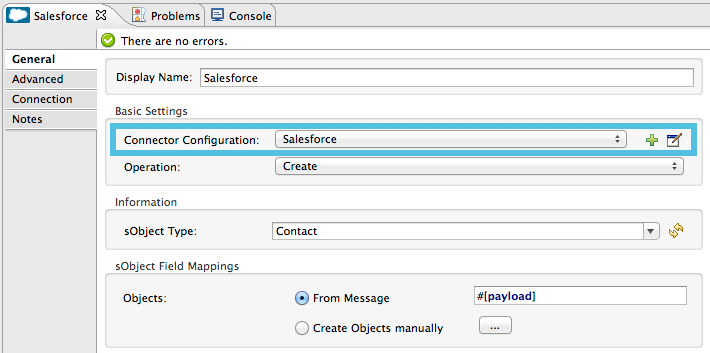Studio Visual Editor
-
In the visual editor, click the Global Elements tab at the base of the canvas to access a list of all global elements in an application.

-
Click Create to add a new global element.

-
In the Choose Global Type wizard, navigate the directories or use the filter to select the type of global element you wish to create, then click OK.

-
Define the configurable parameters of your global element, then click OK to save.
-
To configure a local element in flow to reference a global element, use the drop-down menu next to the Connector Configuration, Connector Endpoint, or other reference field to select a global element from a list of those you have created.

|
You can create a new global element from within a local element in your flow. Click the plus icon next to the Connector Configuration, Connector Endpoint, or other reference field, then follow the steps above to configure a global element. Click the edit icon to edit an existing global element. 
|
XML Editor or Standalone
-
In the XML Editor in Studio, or in your XML config file, create a global element above and outside any flows within your application.
-
Define the values of attributes associated with the type of global element you added (see Examples below).
-
To configure an element in flow to reference a global element, add a
config-reforconnector-refattribute to the element. The example below includes a global Salesforce element (sfdc:config), and a flow which includes a Salesforce connector (sfdc:create) that references the global Salesforce element.
<?xml version="1.0" encoding="UTF-8"?>
<mule xmlns:data-mapper="http://www.mulesoft.org/schema/mule/ee/data-mapper" xmlns:sfdc="http://www.mulesoft.org/schema/mule/sfdc" xmlns:file="http://www.mulesoft.org/schema/mule/file" xmlns:tracking="http://www.mulesoft.org/schema/mule/ee/tracking" xmlns="http://www.mulesoft.org/schema/mule/core" xmlns:doc="http://www.mulesoft.org/schema/mule/documentation" xmlns:spring="http://www.springframework.org/schema/beans" xmlns:xsi="http://www.w3.org/2001/XMLSchema-instance" xsi:schemaLocation="http://www.mulesoft.org/schema/mule/file http://www.mulesoft.org/schema/mule/file/current/mule-file.xsd
http://www.mulesoft.org/schema/mule/ee/data-mapper http://www.mulesoft.org/schema/mule/ee/data-mapper/current/mule-data-mapper.xsdhttp://www.mulesoft.org/schema/mule/sfdc http://www.mulesoft.org/schema/mule/sfdc/current/mule-sfdc.xsd
http://www.springframework.org/schema/beans http://www.springframework.org/schema/beans/spring-beans-current.xsd
http://www.mulesoft.org/schema/mule/core http://www.mulesoft.org/schema/mule/core/current/mule.xsd
http://www.mulesoft.org/schema/mule/ee/tracking http://www.mulesoft.org/schema/mule/ee/tracking/current/mule-tracking-ee.xsd">
<sfdc:config name="Salesforce1" username="username" password="password" doc:name="Salesforce" securityToken="IQZjCdweSF45JD90Me2BWLLVDo">
<sfdc:connection-pooling-profile initialisationPolicy="INITIALISE_ONE" exhaustedAction="WHEN_EXHAUSTED_GROW"/>
</sfdc:config>
<flow name="Contacts_to_SFDC" doc:name="Contacts_to_SFDC">
...
<sfdc:create config-ref="Salesforce1" type="" doc:name="Salesforce Connector">
<sfdc:objects ref="#[payload]"/>
</sfdc:create>
</flow>
</mule>



